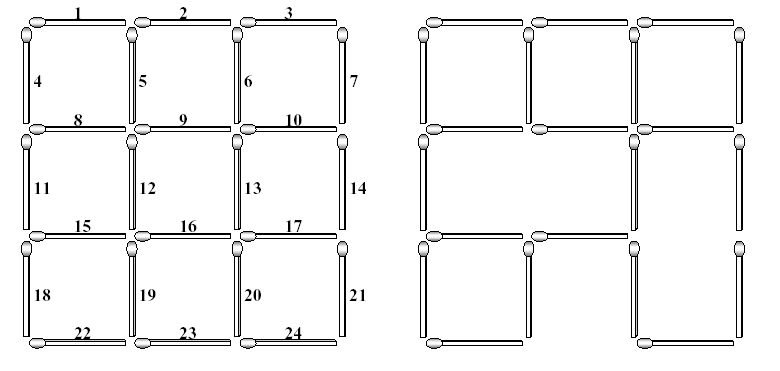Square Destroyer
| Time Limit: 1000MS | Memory Limit: 10000K | |
| Total Submissions: 4577 | Accepted: 2053 |
Description
The left figure below shows a complete 3*3 grid made with 2*(3*4) (=24) matchsticks. The lengths of all matchsticks are one. You can find many squares of different sizes in the grid. The size of a square is the length of its side. In the grid shown in the left figure, there are 9 squares of size one, 4 squares of size two, and 1 square of size three.
Each matchstick of the complete grid is identified with a unique number which is assigned from left to right and from top to bottom as shown in the left figure. If you take some matchsticks out from the complete grid, then some squares in the grid will be destroyed, which results in an incomplete 3*3 grid. The right figure illustrates an incomplete 3*3 grid after removing three matchsticks numbered with 12, 17 and 23. This removal destroys 5 squares of size one, 3 squares of size two, and 1 square of size three. Consequently, the incomplete grid does not have squares of size three, but still has 4 squares of size one and 1 square of size two.

As input, you are given a (complete or incomplete) n*n grid made with no more than 2n(n+1) matchsticks for a natural number 5 <= n . Your task is to compute the minimum number of matchsticks taken
out to destroy all the squares existing in the input n*n grid.
Input
The input consists of T test cases. The number of test cases (T ) is given in the first line of the input file.
Each test case consists of two lines: The first line contains a natural number n , not greater than 5, which implies you are given a (complete or incomplete) n*n grid as input, and the second line begins with a nonnegative integer k , the number of matchsticks that are missing from the complete n*n grid, followed by
k numbers specifying the matchsticks. Note that if k is equal to zero, then the input grid is a complete n*n grid; otherwise, the input grid is an incomplete n*n grid such that the specified k matchsticks are missing from the complete n*n grid.
Output
Print exactly one line for each test case. The line should contain the minimum number of matchsticks that have to be taken out to destroy all the squares in the input grid.
Sample Input
2
2
0
3
3 12 17 23
Sample Output
3
3Source
代码借鉴:https://blog.csdn.net/qq_25978793/article/details/49093589
#include <cstdio>
#include <algorithm>
#include <cstring>
#include <vector>
using namespace std;
int T, n, k, totstick, totsquare, neibor;
int ans, maxd; //ans与估值下限都是全局变量
int exi[65], temp[65]; //temp和exi都是全局变量函数
vector <int> stick[65];
vector <int> square[65];
int h() //估值函数
{ // 估值就是放缩,估,合理地放缩
//拿走一条边等价拿走怎个正方形造成的破化。
int res=0;
for(int i=1;i<=totsquare;i++)
temp[i]=exi[i];
for(int i=1;i<=totsquare;i++)
if(!temp[i]) //找到所有不被坏的正方形,一个正方形一条边就能破坏
{ //但一条边能破坏多个正方形,因为不能原来的储存被破坏
//所以要用临时的数组存储状态
res++;
temp[i]-=square[i].size();
for(int j=0;j<square[i].size();j++) //当前正方形的每一条边。
for(int l=0;l<stick[square[i][j]].size();l++) //每一条边对应的正方形
{
temp[stick[square[i][j]][l]]--; //破坏
}
}
return res; //
}
bool dfs(int sum) //深搜是看能不能在这个估值下限,找到能够能拆掉所有正方形的方法。
{
if(sum+h()>=maxd) //利用下界估值,减少递归次数,减少花费的时间
return 0; //在趋近最优解时,能高效地节省时间
int tmp=1;
while(exi[tmp]<0&&tmp<=totsquare) //一直循环都不存在的话,tmp就会超过totsquare
tmp++; //也就实现了最终目的
//再次强调正方形有大也有小,边长从小到大,对应的正方形序号从小增到大
if(tmp>totsquare)
{
ans=min(sum,ans);
return 1;
}
for(int i=0;i<square[tmp].size();i++) //对当前正方形进行破坏,枚举每一条边破坏的情况
{ //感觉这里就是枚举了,没有做任何优化
int sti=square[tmp][i]; //提取当前正方形的每一根火柴
for(int j=0;j<stick[sti].size();j++) //对每一根火柴,枚举其对应的所有正方形
exi[stick[sti][j]]--; //删掉该火柴的每一个对应正方形
if(dfs(sum+1)) //去掉一条边,sum就加1了
return 1; //成功了肯定不用回溯,直接return就行
for(int j = 0; j < stick[sti].size(); j++)
exi[stick[sti][j]]++; //回溯。
}
return 0;
}
int main()
{
int i;
scanf("%d",&T);
while(T--)
{
scanf("%d %d",&n,&k);
totstick=(n+1)*n*2;
totsquare=0;
neibor=n*2+1;
for(i=1;i<65;i++)
{
stick[i].clear();
square[i].clear();
}
for(int sz=1;sz<=n;sz++) //sz是边的大小。
//因为正方形的边是从1~n逐级增大的。
//因为有小大正方形之分
//利用这个sz可以每次将所有边长为sz的正方形的边序号定位
//这个序号还是白皮书上的序号吧
for(int i=1;i<=(n-sz)*neibor+1;i+=neibor) //i是一个正方形的上边的开始
for(int j=i;j-i+sz<=n;j++) //j是一个正方形的左边的开始
{
totsquare++;
for(int l=j;l-j<sz;l++) //l开始枚举
{ //这里的sz就是正方形边长的限制
square[totsquare].push_back(l); //这存的是同一个正方形的上边的所有火柴
square[totsquare].push_back(l+sz*neibor); //这存的是同一个正方形的下边的所有火柴
stick[l].push_back(totsquare); //这存的是该火柴所属的正方形,正方形的上火柴
stick[l+sz*neibor].push_back(totsquare); //这存的是该火柴所属的正方形,正方形的下火柴
}
for(int l = j+n; (l-j-sz)/neibor < sz; l += neibor) //同理,这里是左右
{
square[totsquare].push_back(l);
square[totsquare].push_back(l+sz);
stick[l].push_back(totsquare);
stick[l+sz].push_back(totsquare);
}
}
memset(exi,0,sizeof(exi)); //重置存在数组,0,是表示存在。
for(int i = 1; i <= k; i++)
{
int a;
scanf("%d",&a);
for(int j=0;j<stick[a].size();j++)
{
exi[stick[a][j]]--; //stcik[t][j]表示t这条木棍对应的正方形
}
totstick --; //木棍拿走,总共的木棍减1.
}
ans=totstick; //一开始ans=目前最大的木棍数。
for(maxd=1;;maxd++) //定义估值下限,下限肯定是从0开始的。但这里用的是1开始
{ //额,感觉这道题就不会有不用拿的情况的。
if(dfs(0)) //估值下限为全局变量
break; //估值下限的使用方法,就是用这个for从最小开始枚举。
} //一旦找到解,则x就是最优解。
printf("%d\n",ans);
}
return 0;
}